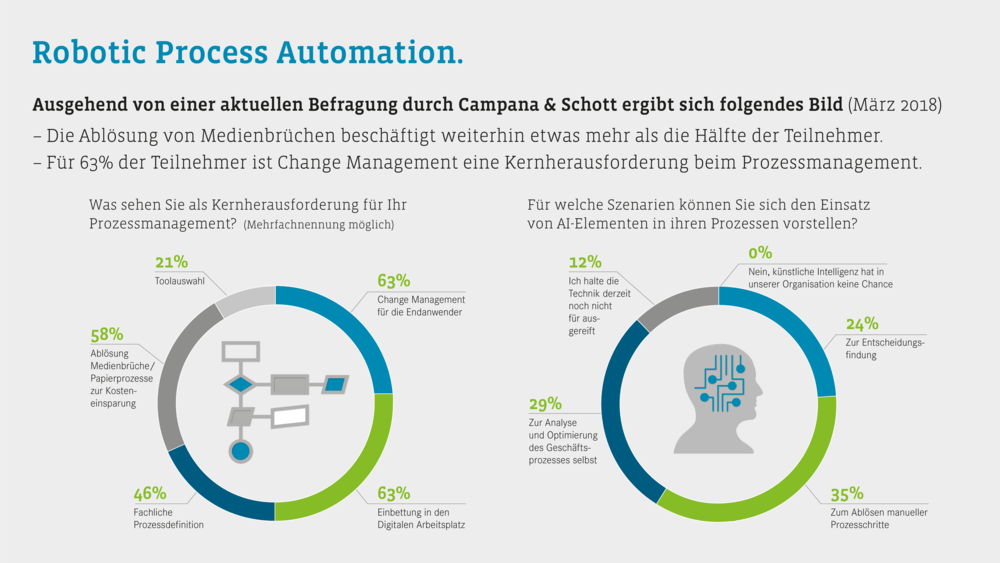Paula and Scotty
Ten times a week, Paula is approached by employees asking where they can order more business cards. Because Paula always knows the answer. Even more frequently, people approach other colleagues at Campana & Schott before they are directed to Paula.
Then Paula spends a lot of time telling them how to order new business cards, and where to enter the contact information. Of course, Paula could do much more useful things with her time.
But for the past few weeks, Paula has received lots of help from Scotty. He explains the order process, even understands vague inquiries, and sends the required links right away. And he never loses his cool.
What’s so special about Scotty: Scotty is a chatbot. In other words, a virtual Campana & Schott employee that is much appreciated by his colleagues. Because what was once conceived as an internal experiment already delivers direct benefits today. Nothing earthshattering, but valuable help nonetheless. And not just with business cards.
New business processes – the core of the digital transformation
Ultimately, it is optimized or entirely new business processes that account for the digital transformation. In this context, there are two sides to the digital transformation. One involves internal optimization. Digitization is supposed to provide a solution for the efficiency and cost pressures in the companies – ranging from large processes to the simplified ordering of business cards. The other side refers to the external environment: First and foremost, digitization is supposed to make the interface to the customer more comfortable, comprehensive and benefitoriented. The increasing personalization of the customer experience is an added factor. The automation of business processes takes on an entirely new significance on both sides. Because today, the most significant changes to processes come from new technologies. By automating business processes, we lead companies into a new age. Many already find it completely natural that robots or bots take over work steps for us.
Automating business processes with chatbot technologies – a short overview
Rapid change has occurred in a very short time. Currently available technologies create entirely new and de facto groundbreaking possibilities for automating processes. This development is enabled by the competitively-priced availability of the new technologies and particularly the ability to combine these technologies. Especially the ability to understand and “speak” independently is a real game changer. Furthermore, the independent selection and initiation of processes represents an added factor in this regard (“Hello Scotty, are my business cards read yet?”). This typically involves a combination of the following technologies:
- Voice recognition and voice generation (“conversations”) have become quite sophisticated and ready to be put into practice
- Intelligent workflows that are data-driven, or that can be started automatically
- Artificial intelligence (AI) and machine learning help us to search through and combine existing data and documents, and analyze both structured and unstructured information.
- Robotic Process Automation (RPA) (robot-controlled process automation) is a particularly powerful technology in this context: For example, intelligent software can edit input fields, doing away with manual entry tasks.
This is where there is a lot of action at the moment. While integration projects were previously used to replace manual copy and paste functions (media disruptions between applications), this is now done with RPA, which is many times faster and also cheaper. In turn, RPA is a good fit for any situation in which a (native) system integration appears to be very cumbersome or risky / unpredictable. This means that the robot takes over the copy and paste functions between the applications at a fraction of the cost. Automation is replacing integration.
What can companies do now? Customer Service Management is a good start
Larger companies in particular are not usually in a position to radically change their central processes; instead, they need a certain amount of lead time. As a result, many companies first think about automating non-critical processes. Since they do not have a direct reference to the customer, it seems that internal processes are better suited (or less risky) for automation and robotization.
But another interesting option from the viewpoint of Campana & Schott is the robotization of Customer Service Management processes. Service processes feature a reference to the customer, but they do not directly intervene in the value chain. At the same time, they can increase customer satisfaction as customer inquiries are answered quickly and waiting loops are avoided. Many companies have 50 to 100 processes in this area alone, which are well suited for automation the use of chatbots – hence a good starting point overall.
New change management is required
Technology is just half of the story – the other is new change management. The use of bots will be the first noticeable wave in which employees’ task areas are taken over by technologies as part of the digital transformation process. This transformation should not just be managed; rather, we must take an active part in shaping this transformation. Conventional objectives such as “making sure employees are taken along on the journey” or “making sure those affected are notified earlier this time” are not sufficient by a long shot. Internally, new questions must be answered: How are the employees integrated into the conversion process? What digital skills do employees have to acquire in this context? How should employees reduce their routine tasks and instead take on higher-quality tasks, e.g. tasks with a personal customer reference? The question for society: What type of work do these employees want to perform in the future? What type of work are they supposed to perform in the future?
Paula at least is not concerned. She is happy that Scotty looks after so many routine tasks, allowing her to focus more on providing advice to her internal customers.


